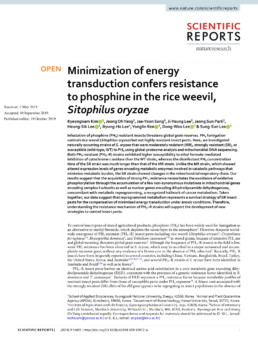Click the link above for more details.
Minimization of energy transduction confers resistance to phosphine in the rice weevil, Sitophilus oryzae.
Abstract
Infestation of phosphine (PH3) resistant insects threatens global grain reserves. PH3 fumigation controls rice weevil (Sitophilus oryzae) but not highly resistant insect pests. Here, we investigated naturally occurring strains of S. oryzae that were moderately resistant (MR), strongly resistant (SR), or susceptible (wild-type; WT) to PH3 using global proteome analysis and mitochondrial DNA sequencing. Both PH3 resistant (PH3-R) strains exhibited higher susceptibility to ethyl formate-mediated inhibition of cytochrome c oxidase than the WT strain, whereas the disinfectant PH3 concentration time of the SR strain was much longer than that of the MR strain. Unlike the MR strain, which showed altered expression levels of genes encoding metabolic enzymes involved in catabolic pathways that minimize metabolic burden, the SR strain showed changes in the mitochondrial respiratory chain. Our results suggest that the acquisition of strong PH3 resistance necessitates the avoidance of oxidative phosphorylation through the accumulation of a few non-synonymous mutations in mitochondrial genes encoding complex I subunits as well as nuclear genes encoding dihydrolipoamide dehydrogenase, concomitant with metabolic reprogramming, a recognized hallmark of cancer metabolism. Taken together, our data suggest that reprogrammed metabolism represents a survival strategy of SR insect pests for the compensation of minimized energy transduction under anoxic conditions. Therefore, understanding the resistance mechanism of PH3-R strains will support the development of new strategies to control insect pests.
CategoryPeer-reviewed PublicationsDate2019.10Linkwww.ncbi.nlm.nih.gov
